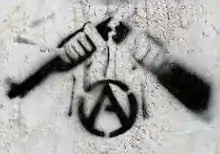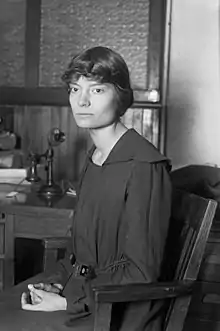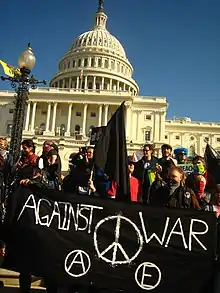Anarcho-pacifism
Anarcho-pacifism, also referred to as anarchist pacifism and pacifist anarchism, is an anarchist school of thought that advocates for the use of peaceful, non-violent forms of resistance in the struggle for social change.[1][2] Anarcho-pacifism rejects the principle of violence which is seen as a form of power and therefore as contradictory to key anarchist ideals such as the rejection of hierarchy and dominance.[2][3] Many anarcho-pacifists are also Christian anarchists, who reject war and the use of violence.[4]
| Part of a series on |
| Anarchism |
|---|
 |
Anarcho-pacifists do not reject the use of non-violent revolutionary action against capitalism and the state with the purpose of establishing a peaceful voluntarist society.[1][5] The main early influences were the philosophies of Henry David Thoreau and Leo Tolstoy while later the ideas of Mahatma Gandhi gained significance.[1][2] Anarcho-pacifist movements primarily emerged in the Netherlands, Russia, the United Kingdom and the United States before and during World War II.[2]
History
Henry David Thoreau (1817–1862) was an important early influence in individualist anarchist thought in the United States and Europe. Thoreau's essay "Civil Disobedience" (Resistance to Civil Government) was named as an influence by Leo Tolstoy, Martin Buber, Mahatma Gandhi and Martin Luther King Jr. due to its advocacy of nonviolent resistance.[1] According to the Peace Pledge Union of Britain, it was also the main precedent for anarcho-pacifism.[1] Thoreau himself did not subscribe to pacifism, and did not reject the use of armed revolt. He demonstrated this with his unqualified support for John Brown and other violent abolitionists,[6] writing of Brown that "The question is not about the weapon, but the spirit in which you use it."[7]
In the 1840s, the American abolitionist and advocate of nonresistance Henry Clarke Wright and his English follower Joseph Barker rejected the idea of governments and advocated a form of pacifist individualist anarchism.[8] At some point anarcho-pacifism had as its main proponent Christian anarchism. The Tolstoyan movement in Russia was the first large-scale anarcho-pacifist movement.

Violence has always been controversial in anarchism. While many anarchists embraced violent propaganda of the deed during the nineteenth century, anarcho-pacifists directly opposed violence as a means for change. Tolstoy argued that anarchism must be nonviolent since it is, by definition, opposition to coercion and force, and that since the state is inherently violent, meaningful pacifism must likewise be anarchistic. Ferdinand Domela Nieuwenhuis was also instrumental in establishing the pacifist trend within the anarchist movement.[2] In France anti-militarism appeared strongly in individualist anarchist circles, as Émile Armand co-founded "Ligue Antimilitariste" in December 1902 with fellow anarchists Georges Yvetot, Henri Beylie, Paraf-Javal, Albert Libertad and Émile Janvion. The Ligue antimilitariste was to become the French section of the Association internationale antimilitariste (AIA) founded in Amsterdam in 1904.[9]
Tolstoy's philosophy was cited as a major inspiration by Mohandas Gandhi, an Indian independence leader and pacifist who self-identified as an anarchist. "Gandhi's ideas were popularised in the West in books such as Richard Gregg's The Power of Nonviolence (1935), and Bart de Ligt's The Conquest of Violence (1937). The latter is particularly important for anarchists since, as one himself, de Ligt specifically addressed those who lust for revolution. 'The more violence, the less revolution,' he declared. He also linked Gandhian principled nonviolence with the pragmatic nonviolent direct action of the syndicalists. (The General Strike is an expression of total noncooperation by workers, though it should be added that most syndicalists believed that the revolution should be defended by armed workers.)"[1] The Conquest of Violence alludes to Kropotkin's The Conquest of Bread.[10]

As a global movement, anarchist pacifism emerged shortly before World War II in the Netherlands, United Kingdom and United States and was a strong presence in the subsequent campaigns for nuclear disarmament. The American writer Dwight Macdonald endorsed anarcho-pacifist views in the 1940s and used his journal politics to promote these ideas.[11] For Andrew Cornell "Many young anarchists of this period departed from previous generations both by embracing pacifism and by devoting more energy to promoting avant-garde culture, preparing the ground for the Beat Generation in the process. The editors of the anarchist journal Retort, for instance, produced a volume of writings by WWII draft resistors imprisoned at Danbury, Connecticut, while regularly publishing the poetry and prose of writers such as Kenneth Rexroth and Norman Mailer. From the 1940s to the 1960s, then, the radical pacifist movement in the United States harbored both social democrats and anarchists, at a time when the anarchist movement itself seemed on its last legs."[10][12] A leading British anarcho-pacifist was Alex Comfort who considered himself "an aggressive anti-militarist," and he believed that pacifism rested "solely upon the historical theory of anarchism."[13][14] He was an active member of CND.[15]
Among the works on anarchism by Comfort is Peace and Disobedience (1946), one of many pamphlets he wrote for Peace News and the Peace Pledge Union, and Authority and Delinquency in the Modern State (1950).[13] He exchanged public correspondence with George Orwell defending pacifism in the open letter/poem "Letter to an American Visitor" under the pseudonym "Obadiah Hornbrooke."[16]
In the 1950s and 1960s, anarcho-pacifism "began to gel, tough-minded anarchists adding to the mixture their critique of the state, and tender-minded pacifists their critique of violence".[1] Within the context of the emergence of the New Left and the Civil Rights Movement, "several themes, theories, actions, all distinctly libertarian, began to come to the fore and were given intellectual expression by the American anarcho-pacifist, Paul Goodman."[1]

Other notable anarcho-pacifist historical figures include Ammon Hennacy, Dorothy Day and Jean-Paul Sartre, albeit the latter only for a brief period between 1939 and 1940 .[17] Dorothy Day, (8 November 1897 – 29 November 1980) was an American journalist, social activist and devout Catholic convert; she advocated the Catholic economic theory of distributism. She was also considered to be an anarchist,[18][19][20] and did not hesitate to use the term.[21] In the 1930s, Day worked closely with fellow activist Peter Maurin to establish the Catholic Worker movement, a nonviolent, pacifist movement that continues to combine direct aid for the poor and homeless with nonviolent direct action on their behalf. The cause for Day's canonization is open in the Catholic Church. Ammon Hennacy (24 July 1893 – 14 January 1970) was an American pacifist, Christian anarchist, vegetarian, social activist, member of the Catholic Worker Movement and a Wobbly. He established the "Joe Hill House of Hospitality" in Salt Lake City, Utah and practiced tax resistance. Charles-Auguste Bontemps was a prolific author mainly in the anarchist, freethinking, pacifist and naturist press of the time.[22] His view on anarchism was based around his concept of "Social Individualism" on which he wrote extensively.[22] He defended an anarchist perspective which consisted on "a collectivism of things and an individualism of persons."[23] Gérard de Lacaze-Duthiers was a French writer, art critic, pacifist and anarchist. Lacaze-Duthiers, an art critic for the Symbolist review journal La Plume, was influenced by Oscar Wilde, Nietzsche and Max Stirner. His (1906) L'Ideal Humain de l'Art helped found the 'Artistocracy' movement – a movement advocating life in the service of art.[24] His ideal was an anti-elitist aestheticism: "All men should be artists".[25] Jean-René Saulière (also René Saulière) (Bordeaux, 6 September 1911 – 2 January 1999) was a French anarcho-pacifist, individualist anarchist[26] and freethought writer and militant who went under the pseudonym André Arru.[27][28][29] During the late 1950s he establishes inside the Fédération des Libres Penseurs des Bouches du Rhône, the Group Francisco Ferrer[30] and in 1959 he joins the Union des Pacifistes de France (Union of Pacifists of France).[30] From 1968 to 1982, Arru alongside the members of the Group Francisco Ferrer publishes La Libre Pensée des Bouches du Rhône.

"Movement for a New Society (MNS), a national network of feminist radical pacifist collectives that existed from 1971 to 1988",[10] is sometimes identified as anarchist,[12] although they did not identify themselves as such.[31] For Andrew Cornell "MNS popularized consensus decision-making, introduced the spokescouncil method of organization to activists in the United States, and was a leading advocate of a variety of practices – communal living, unlearning oppressive behavior, creating co-operatively owned businesses – that are now often subsumed under the rubric of "prefigurative politics."[10] MNS leader George Lakey stated that "anarchists claim me but I'm always a little surprised when they do because I'm fond of social democracy as it's been developed in Norway." Lakey has supported electoral politics, including the re-election of Barack Obama as U.S. president.[32]
Thought
According to the authors of An Anarchist FAQ, "the attraction of pacifism to anarchists is clear. Violence is authoritarian and coercive, and so its use does contradict anarchist principles... (Errico) Malatesta is even more explicit when he wrote that the "main plank of anarchism is the removal of violence from human relations".[33]

Anarcho-pacifists tend to see the state as 'organised violence' and so they see that "it would therefore seem logical that anarchists should reject all violence".[1] Anarcho-pacifism criticizes the separation between means and ends. "Means... must not merely be consistent with ends; this principle, though preferable to 'the end justifies the means', is based on a misleading dichotomy. Means are ends, never merely instrumental but also always expressive of values; means are end-creating or ends-in-the making".[1]
An anarcho-pacifist critique of capitalism was provided by Bart de Ligt in his The Conquest of Violence. An Anarchist FAQ reports how "all anarchists would agree with de Ligt on, to use the name of one of his book's chapters, "the absurdity of bourgeois pacifism." For de Ligt, and all anarchists, violence is inherent in the capitalist system and any attempt to make capitalism pacifistic is doomed to failure. This is because, on the one hand, war is often just economic competition carried out by other means. Nations often go to war when they face an economic crisis, what they cannot gain in economic struggle they attempt to get by conflict. On the other hand, "violence is indispensable in modern society... [because] without it the ruling class would be completely unable to maintain its privileged position with regard to the exploited masses in each country. The army is used first and foremost to hold down the workers... when they become discontented." [Bart de Ligt, Op. Cit., p. 62] As long as the state and capitalism exist, violence is inevitable and so, for anarcho-pacifists, the consistent pacifist must be an anarchist just as the consistent anarchist must be a pacifist".[33]
A main component of anarcho-pacifist strategy is civil disobedience as advocated by the early anarchist thinker Henry David Thoreau in the essay of the same name from 1849 (although Thoreau strongly supported the gun rights and self-defense).[1] Leo Tolstoy was influenced by it and he saw that a "great weapon for undermining (rather than overthrowing) the state was the refusal by individuals to cooperate with it and obey its immoral demands".[1] Also the concepts of passive and active resistance have relevance as they were developed later by Mohandas Gandhi.[1]
For anarchist historian George Woodcock "the modern pacifist anarchists,...have tended to concentrate their attention largely on the creation of libertarian communities – particularly farming communities – within present society, as a kind of peaceful version of the propaganda by deed. They divide, however, over the question of action.".[2] Anarcho-pacifists can even accept "the principle of resistance and even revolutionary action (nonviolent revolution), provided it does not incur violence, which they see as a form of power and therefore nonanarchist in nature. This change in attitude has led the pacifist anarchists to veer toward the anarcho-syndicalists, since the latter's concept of the general strike as the great revolutionary weapon made an appeal to those pacifists who accepted the need for fundamental social change but did not wish to compromise their ideal by the use of negative (i.e., violent) means."[2]
Ideological variance
Anarcho-pacifism is frequently associated with various forms of religious anarchism such as Tolstoyan Christian anarchism and Buddhist anarchism. Notably, Christian anarchism places emphasis on Jesus Christ's blessing of peacemakers and teachings involving non-violent resistance.[34] Concerning the anarchistic characteristics of Christianity, Greek author Alexandre Christoyannopoulos argues that the concept of the state should be rejected by Christians due to its inherent contradiction of the teachings of the religion.[4] Following the definition of the state posited by Max Weber in his 1921 essay Politik als Beruf, Christoyannopoulos contends that the state is founded upon a monopoly over the use of violent force in order to enforce law and order, and is therefore directly at odds with the fundamental teachings of Jesus Christ.[4][35] Reflecting on the implications of this contradictory relationship, Christoyannopoulos invokes the Tolstoyan notion that the force utilized by the justice system to enforce the outcomes of legal proceedings is also at odds with the teachings of Christianity.[4] Aylmer Maude (the friend, biographer and translator of Leo Tolstoy) states that Christianity involves anarchism as it necessitates the "abolition of all compulsory legislation, law courts, police, and prisons, as well as all forcible restraint of man by man".[4][36] Due to Tolstoy's religious views combined with his advocacy for the total dismantlement of the state and its apparatus in favour of the establishment of a voluntarist society, he is seen as a prominent instigator of Christian anarchism.[5][4]
Anarcho-pacifism is often combined with socialist criticism of capitalism regarding economic class.[5] The anarcho-pacifist ideal of a peaceful classless society is claimed to be incompatible with the competitive nature of capitalism which can ultimately lead to violent conflict.[5] Anarcho-pacifists frequently denounce the perceived tendency of the capitalist economic system to perpetuate systematic violence in the forms of exploitation, hierarchies of political and economic power as well as dispossession.[37] However, the socialist criticism of capitalism that often appear within the movement does not imply that anarcho-pacifism is inherently social anarchist in nature.[5] Anarchist schools of thought can be generally distinguished from one another by their perspectives on two key elements, namely revolutionary methods and economic organisation.[2] Anarcho-pacifism differs from social anarchism in rejecting the use of violent revolutionary methods to achieve social change and the abolition of the state.[5]
Irreligious or even anti-religious tendencies have emerged such as the French individualist anarchist anarcho-pacifist tendency exemplified by authors and activists such as Charles-Auguste Bontemps, André Arru and Gérard de Lacaze-Duthiers which aligned itself with atheism and freethought. The anarcho-punk band Crass polemicised a variant of anarcho-pacifism whilst at the same time explicitly rejecting all religions, especially the symbols of establishment Christian theology.[38] Opposition to the use of violence has not prohibited anarcho-pacifists from accepting the principle of resistance or even revolutionary action provided it does not result in violence. It was their approval of such forms of opposition to power that led some anarcho-pacifists to endorse the anarcho-syndicalist concept of the general strike as the great revolutionary weapon.[2]
Criticism
Peter Gelderloos criticizes the idea that nonviolence is the only way to fight for a better world. According to Gelderloos, pacifism as an ideology serves the interests of the state and is hopelessly caught up psychologically with the control schema of patriarchy and white supremacy.[39] The influential publishing collective CrimethInc. notes that "violence" and "nonviolence" are politicized terms that are used inconsistently in discourse, depending on whether or not a writer seeks to legitimize the actor in question. They argue that "[i]t's not strategic [for anarchists] to focus on delegitimizing each other's efforts rather than coordinating to act together where we overlap". For this reason, both CrimethInc. and Gelderloos advocate for diversity of tactics.[40]
Albert Meltzer criticised extreme pacifism as authoritarian, believing that "The cult of extreme nonviolence always implies an elite." However, he did believe that less extreme pacifism was compatible with anarchism.[41]
References
- Ostergaard, Geoffrey (1982). Resisting the Nation State: The Pacifist and Anarchist Traditions. London: Peace Pledge Union. ISBN 9780902680357.
- Woodcock, George (1962). Anarchism: A History of Libertarian Ideas and Movements. Penguin Books. ISBN 9780140168211.
- Williams, Dana (24 August 2017). "Contemporary anarchist and anarchistic movements". Sociology Compass. 12 (6): e12582. doi:10.1111/soc4.12582.
- Christoyannopoulos, Alexandre (2010). "A Christian Anarchist Critique of Violence: From Turning the Other Cheek to a Rejection of the State". In King, Stephen; Salzani, Carlo; Staley, Owen (eds.). Law, Morality and Politics: Global Perspectives on Violence and the State. Oxfordshire: Inter-Disciplinary Press. pp. 19–26. ISBN 978-1-84888-041-2.
- Atack, Iain (2005). The Ethics of Peace and War. Edinburgh: Edinburgh University Press. ISBN 9780748622450.
- "James Mark Shields, "Thoreau's Lengthening Shadow: Pacifism and the Legacy of 'Civil Disobedience'" Bucknell University website" (PDF).
- "Michael Meyer "Thoreau's Rescue of John Brown from History" Studies in the American Renaissance (1980), pp. 301–316". JSTOR 30228175.
- Brock, Peter, Pacifism in Europe to 1914, Princeton, N.J. : Princeton University Press, 1972, ISBN 0691046085 (p. 395-6).
- Miller, Paul B. (2002). From Revolutionaries to Citizens: Antimilitarism in France, 1870–1914. Duke University Press. p. 38. ISBN 0-8223-8058-7.
- Cornell, Andrew (2009). "Anarchism and the Movement for a New Society: Direct Action and Prefigurative Community in the 1970s and 80s". Perspectives on Anarchist Theory. Archived from the original on 18 May 2013.
- Wald, Alan M. The New York Intellectuals: The Rise and Decline of the Anti-Stalinist Left From the 1930s to the 1980s. UNC Press Books, 1987 ISBN 0807841692, (p. 210).
- David Graeber. "THE REBIRTH OF ANARCHISM IN NORTH AMERICA, 1957–2007". HAOL, No. 21 (Invierno, 2010), 123–131
- Rayner, Claire (28 March 2000). "News: Obituaries: Alex Comfort". The Guardian. London. Retrieved 23 August 2008.
- For discussions of Comfort's political views, see Demanding the Impossible: A History of Anarchism (1992) by Peter Marshall, and Anarchist Seeds Beneath the Snow (2006) by David Goodway.
- Scott-Brown, Sophie (2022). "Autonomy". Colin Ward and the Art of Everyday Anarchy. Taylor & Francis. ISBN 978-1-00-062286-7.
- Complete Essays, Journalism and Letters of George Orwell volume II, pg. 294–303
- Taylor, John, "Abandoning Pacifism: The Case of Sartre", Journal of European Studies, Vol. 89, 1993
- Day, Dorothy. On Pilgrimage – May 1974 Archived 7 October 2012 at the Wayback Machine, "There was no time to answer the one great disagreement which was in their minds—how can you reconcile your Faith in the monolithic, authoritarian Church which seems so far from Jesus who "had no place to lay his head," and who said "sell what you have and give to the poor,"--with your anarchism? Because I have been behind bars in police stations, houses of detention, jails and prison farms, whatsoever they are called, eleven times, and have refused to pay Federal income taxes and have never voted, they accept me as an anarchist. And I in turn, can see Christ in them even though they deny Him, because they are giving themselves to working for a better social order for the wretched of the earth."
- Anarchist FAQ – A.3.7 Are there religious anarchists? Archived 23 November 2010 at the Wayback Machine, "Tolstoy's ideas had a strong influence on Gandhi, who inspired his fellow country people to use non-violent resistance to kick Britain out of India. Moreover, Gandhi's vision of a free India as a federation of peasant communes is similar to Tolstoy's anarchist vision of a free society (although we must stress that Gandhi was not an anarchist). The Catholic Worker Movement in the United States was also heavily influenced by Tolstoy (and Proudhon), as was Dorothy Day a staunch Christian pacifist and anarchist who founded it in 1933."
- Reid, Stuart (8 September 2008) Day by the Pool Archived 26 October 2010 at the Wayback Machine, The American Conservative
- Day, Dorothy.On Pilgrimage – February 1974 Archived 6 October 2012 at the Wayback Machine, "The blurb on the back of the book Small Is Beautiful lists fellow spokesmen for the ideas expressed, including "Alex Comfort, Paul Goodman and Murray Bookchin. It is the tradition we might call anarchism." We ourselves have never hesitated to use the word."
- "Ephéméride Anarchiste 9 février". www.ephemanar.net.
- "BONTEMPS Auguste, Charles, Marcel dit « Charles-Auguste » ; « CHAB » ; « MINXIT » - [Dictionnaire international des militants anarchistes]". militants-anarchistes.info.
- Peterson, Joseph (1 August 2010). Gérard De Lacaze-Duthiers, Charles Péguy, and Edward Carpenter: An Examination of Neo-Romantic Radicalism Before the Great War (M.A. thesis). Clemson University. pp. 8, 15–30.
- Lacaze-Duthiers, L'Ideal Humain de l'Art, pp.57–8.
- Guerin, Cedric. "Pensée et action des anarchistes en France: 1950–1970" (PDF). Public Federation. Archived from the original (PDF) on 30 September 2007. Retrieved 31 August 2013.
- "ARRU, André [SAULIÈRE Jean, René, Gaston dit] - [Dictionnaire international des militants anarchistes]". militants-anarchistes.info.
- ""André Arru (aka Jean-René Sauliere)" at "The Anarchist Encyclopedia: A Gallery of Saints & Sinners"". Recollectionbooks.com. Archived from the original on 14 June 2012. Retrieved 29 September 2012.
- "Courte biographie (1ère partie)". Raforum.info. 27 August 1948. Archived from the original on 1 January 2014. Retrieved 29 September 2012.
- "Courte biographie (2ème partie)". Archived from the original on 1 January 2014. Retrieved 8 July 2013.
- Cristol, Julie; Hill, T. L., III (October 2011). "Book Review: Oppose and Propose! Lessons from Movement for New Society by Andrew Cornell". Theory in Action. 4 (4): 115–119. doi:10.3798/tia.1937-0237.11036. ISSN 1937-0229.
{{cite journal}}: CS1 maint: multiple names: authors list (link) - "Zcomm » George Lakey interview". zcomm.org. 7 August 2012.
- "2A.3 What types of anarchism are there?". Archived from the original on 6 July 2013. Retrieved 1 July 2013.
- Underwood, Sam (2018). "Blessed Are the Peacemakers: The Contribution of Christian Nonviolence to Anarchism". Essays in Anarchism and Religion. 2: 196–231. doi:10.16993/bas.g. ISBN 9789176350751.
- Weber, Max (1921). Politics as a Vocation. Munich.
{{cite book}}: CS1 maint: location missing publisher (link) - Maude, Aylmer (2015). The Life of Tolstoy. Creative Media Partners, LLC. p. 36. ISBN 978-1296442323.
- Llewellyn, Joseph (2018). Envisioning an Anarcho-Pacifist Peace: A case for the convergence of anarchism and pacifism and an exploration of the Gandhian movement for a stateless society (PDF). Dunedin: University of Otago. Retrieved 14 May 2020.
- Aitch, Iain (19 October 2007). "Why should we accept any less than a better way of doing things?". The Guardian. Unlimited Arts. London. Archived from the original on 24 July 2008. Retrieved 26 December 2007.
- Gelderloos, Peter (2007). How Nonviolence Protects the State. Cambridge, MA: South End Press. p. 128. ISBN 9780896087729.
- Collective, CrimethInc Ex-Workers (27 March 2012). "CrimethInc. : The Illegitimacy of Violence, the Violence of Legitimacy". CrimethInc.
- Meltzer, Albert (1981). Anarchism: Arguments for and Against. Cienfuegos Press. ISBN 978-0-904564-44-0.


